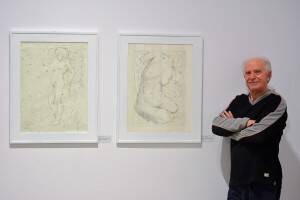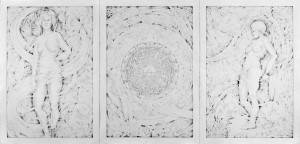John Di Leonardo is our Art Lab artist in residence from June12 until September 3, 2018. During his residency in the Art Lab, John Di Leonardo will be researching the nude theme within Canada’s artistic history, and also will be drawing to create a body of work that explores questions of the nude image as a contentious landscape whose tradition of object of desire and shame informs our social constructs, values and identity.
1. Please tell us a little about yourself.
I am a Brooklin based artist/poet. I received my Hon. BFA from McMaster University with a specialist in figure drawing and painting. I have been a visual arts educator until retirement in 2010. Since retirement I have been a full time artist and loving it!
2. Please tell us more about your exhibition in Gallery A.
While at The RMG I will be working with graphite/pencil medium and the human figure.
My installation at the RMG will explore questions of the nude image as a contentious theme in the history of Canadian art, how its tradition as object of desire and shame informs the trajectory of our social constructs, values and identity.
3. Why did you apply to exhibit in Gallery A?
The RMG has a wonderful library and archival collection. I will continue my archival research from artist’s files, catalogues, newspaper clippings to glean our attitudes about the nude as a theme in Canadian art, specifically in the early part of the 20th century when Canadian identity and modernism in art and culture were being shaped.
Also, I am currently working on a large format triptych series and need a space in which to work. My current studio space is a little claustrophobic!
Lastly, I was interested in working in the Gallery A residency because I wanted to interact with the public and engage them in conversations about themes in Canadian art and how they might shape our sense of identity.
4. What inspires you? Is there a particular artist’s work that has influenced your practice?
The figure has always been a central element in my studio practice for the past three decades, whether working in a realistic, abstract or conceptual vein.
I have always been attracted to artists who reveal a sense of rhythm and energy, or what the Chinese call the CHI a word meaning aliveness, life force inherent in all things. You see this in Botticelli, the German Expressionists, and of course many Chinese painting masters.
5. Why Drawing?
I truly enjoy sketching and drawing. After having worked on mixed media/conceptual series for about eight years, I felt the need to go back to the basic pleasures of art, the physicality of mark-making and the challenges of drawing the human figure.
Drawing helps me to get to the core of a thing, it’s an act of meditation, it is an artist’s most direct and spontaneous form of expression revealing better than any other visual art form the artist’s true personality.
Mirror/Mirror # I : After the Garden, Graphite, 4’ X 9’, 2018
6. What do you hope visitors will feel when they visit your exhibition?
I hope that the exhibition will engage viewers in dialogue and reflective contemplation about our uncomfortable relationship with the nude in art, as they view their own reflection as an integral part of the installation. I hope questions will be explored as why the nude as a theme never took hold in Canada while celebrated in Europe.
Though the nude has never had the capacity of the landscape to become an icon of Canadian identity, it is a very important theme in the evolution of Canadian modernism and a reflection of a changing society in the inter-war years.
That being said, I hope viewers will also simply enjoy the formal and aesthetic qualities the works offer. I would like to end with a quote by Francis Bacon;
“ The greatest art always returns to the vulnerability of the human situation”

